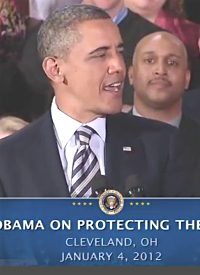
President Obama has once again flexed his autocratic muscle by disregarding the Congress and unilaterally filling seats on the National Labor Relations Board and appointing former Ohio Attorney General Richard Cordray to be the head of the Consumer Financial Protection Bureau.
In Peter Schroeder’s recent article in The Hill, he reports that David Arkush, director of Public Citizen’s Congress Watch division, posits two constitutional pretexts allowing the President to place someone in office whose nomination has already been blocked by the Senate.
First, Arkush insists that Art. 2, Sec.3, of the U.S. Constitution authorizes the President to force the House and Senate to adjourn. Then, once Congress has obeyed that presidential mandate, the President may then lawfully make a “recess appointment.”
Next, Arkush argues that the 20th Amendment orders Congress to assemble at least once a year, with each session beginning on Jan. 3. Arkush says that in order to be able to start a session on Jan. 3, Congress would have to have ended a previous session, thus leaving a gap between the last session and the current session during which the President may squeeze in and make “recess appointments,” obviating the approbation of the Senate.
Following this logic, the President defended his actions, calling them “recess appointments” made in complete compliance with the Constitution’s grant of such power to the President in Article II.
Is the President’s interpretation of Article II correct? To answer that question, one must first look to the text being cited as a justification for the appointments.
Article II, Section 2 of the U.S. Constitution states:
The President shall have Power to fill up all Vacancies that may happen during the Recess of the Senate, by granting Commissions which shall expire at the End of their next Session.
The plain language of that clause seems to authorize the making of what we call recess appointments. That is to say, if the Senate is in recess, then the President is within the sphere of his constitutionally enumerated powers to fill a vacancy that will be valid until the end of the next congressional session.
An additional analysis of the black letter of Article II makes it clear that the Senate must already be in recess in order for an appointment made in its absence to be valid. There is no provision in the Constitution even hinting at the right of the President to use trickery to create artificial breaks in congressional sessions in order to forcibly impose his will in defiance of express Senatorial opposition to it.
It isn’t as if the President hasn’t heard the advice of the Senate (hearings on Cordray’s nomination were blocked in December by a vote of 53-45); he has just chosen to ignore it.
To constitutionalists, an important next step in the analysis would be to discover the intent of the Founders regarding their inclusion of this clause in the Constitution. In the early days of the Republic, the recess periods between congressional sessions lasted months, sometimes as many as nine. Such lengthy breaks made the use of recess appointments necessary in order to prevent necessary offices from remaining unfilled for so long a period.
For example, George Washington took advantage of this authority when in 1795 he appointed John Rutledge of South Carolina to the Supreme Court during a congressional recess. Upon returning to work, the Senate rejected Rutledge, exercising its own right to exercise advice and consent over the nomination of federal officers.
By contrast, President Obama has made frequent and controversial use of the recess appointment clause since taking office in 2009. He has made at least 29 recess appointments during his administration.
Before looking at the Founders’ view of the presidential power of appointment during senatorial recess, let’s begin by investigating their purpose in requiring the President to seek the “advice and consent” of the Senate in the nomination process.
In Federalist 76, Alexander Hamilton explains that the Constitution “requires” the cooperation of the Senate in appointments in order to “check” the President and “to prevent the appointment of unfit characters”; and that “the necessity of its [the Senate’s] co-operation, in the business of appointments, will be a considerable and salutary restraint upon the conduct of that magistrate [the President].”
Addressing the issues underlying the current constitutional crisis specifically, in Federalist 68, Alexander Hamilton writes of the recess appointment clause:
The ordinary power of appointment is confided to the president and senate jointly, and can therefore only be exercised during the session of the senate; but, as it would have been improper to oblige this body to be continually in session for the appointment of officers; and as vacancies might happen in their recess, which it might be necessary for the public service to fill without delay, the succeeding clause is evidently intended to authorize the president, singly, to make temporary appointments "during the recess of the senate, by granting commissions which should expire at the end of their next session.
What, then, was the role the Senate was designed to play in the nomination and appointment process? Again, we turn to the Federalist Papers and Alexander Hamilton:
To what purpose then require the co-operation of the senate? I answer, that the necessity of their concurrence would have a powerful, though in general, a silent operation. It would be an excellent check upon a spirit of favouritism in the president, and would tend greatly to prevent the appointment of unfit characters from state prejudice, from family connexion, from personal attachment, or from a view to popularity. In addition to this, it would be an efficacious source of stability in the administration.
In the preceding quotes from the Federalist Papers, Hamilton makes it clear that while the President is able to make appointments without the advice and consent of the Senate during recesses, there is no provision for the President to assume complete and “arrogant” control of that process while the Senate is sitting.
Admittedly, the usurpation of such authoritarian powers is perfectly in concert with President Barack Obama’s modus operandi. One the last day of 2011, for example, the President not only endowed himself with absolute power to arrest and indefinitely detain American citizens in defiance of habeas corpus and the Sixth Amendment right to counsel, but he expanded the scope of those powers through the penning of a signing statement appended to the act of Congress he signed into law.
It seems strange that between Barack Obama and Richard Cordray — the one the former editor of the University of Chicago Law Review and the other a “professor” at that same renowned institution — neither has a grasp on the very basic constitutional concepts of the separation of powers and checks and balances understood so well by first-year political science students.
When asked by reporters after stepping off Air Force One in Cleveland (his hometown) what he planned to do now that he was in charge of the CFPB, Cordray demonstrated his affinity for enlarging the borders of power: “We’re going to begin working to expand our program to non-banks, which is an area we haven’t been able to touch before now,” he said.
Related articles:
Obama Circumvents Congress to Make Recess Appts.
Obama Appoints Richard Cordray Consumer Watchdog Chief
Photo: President Obama speaks on appointing Richard Cordray, January 4: White House photo



